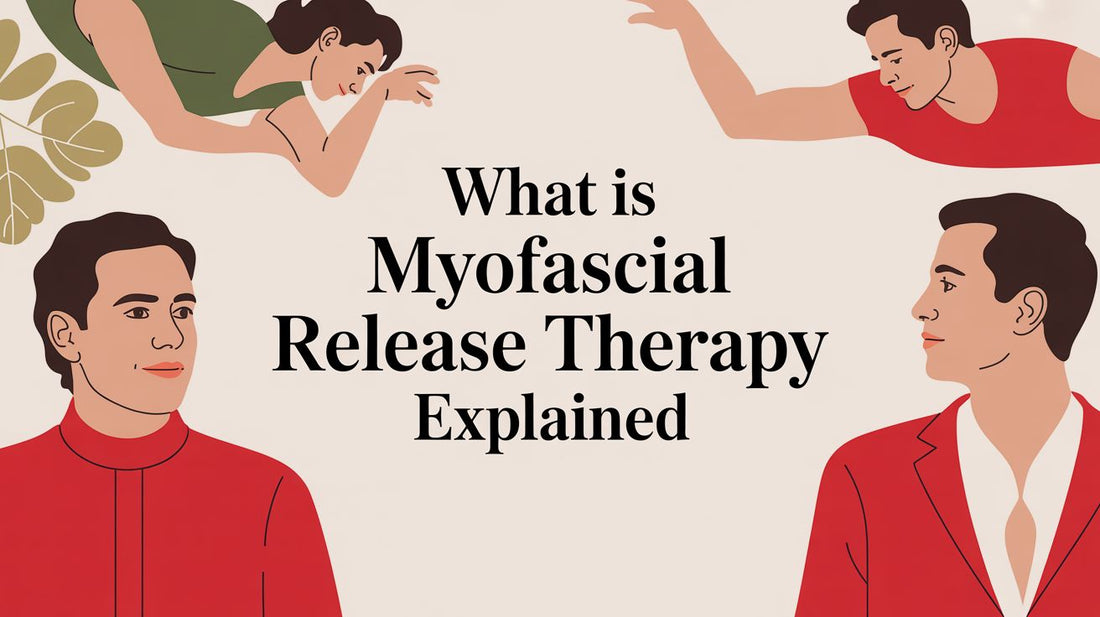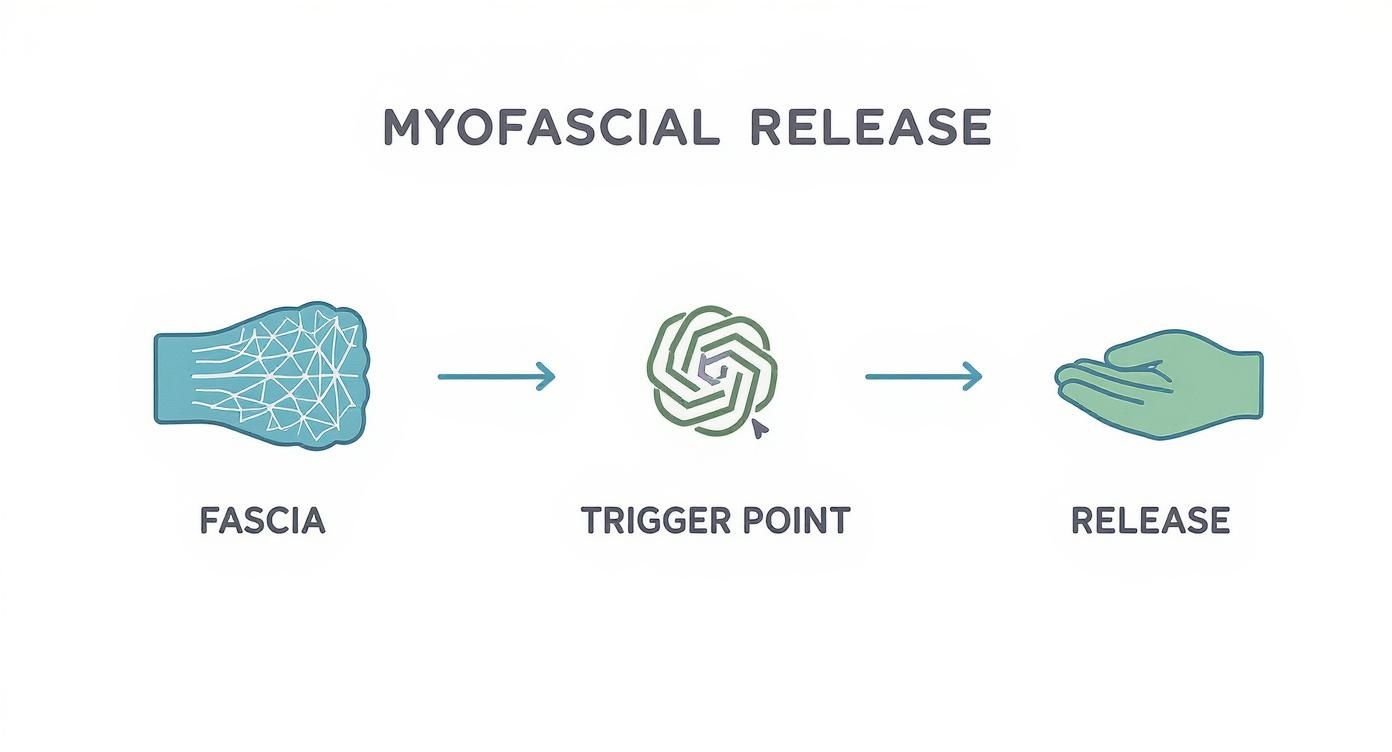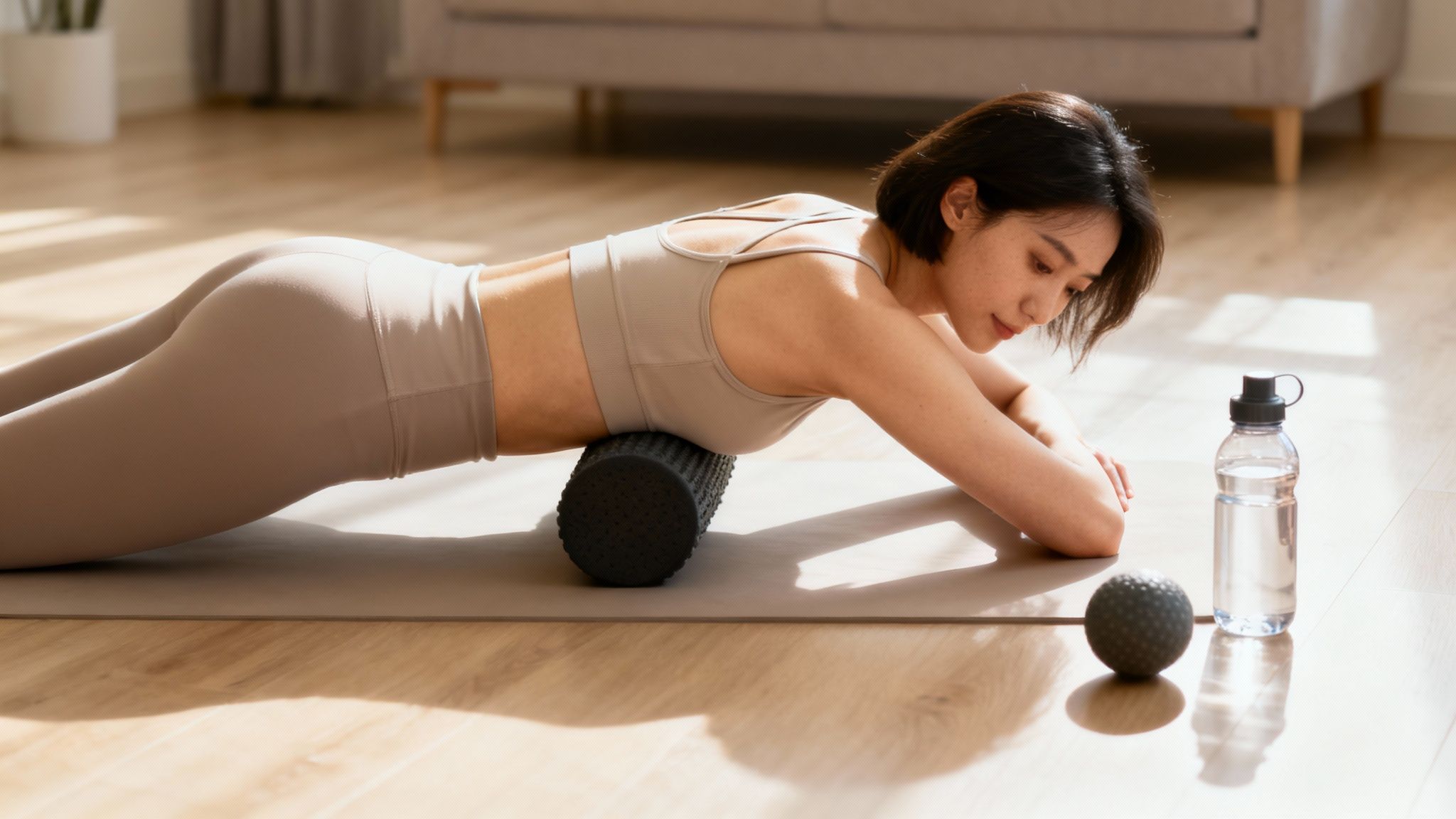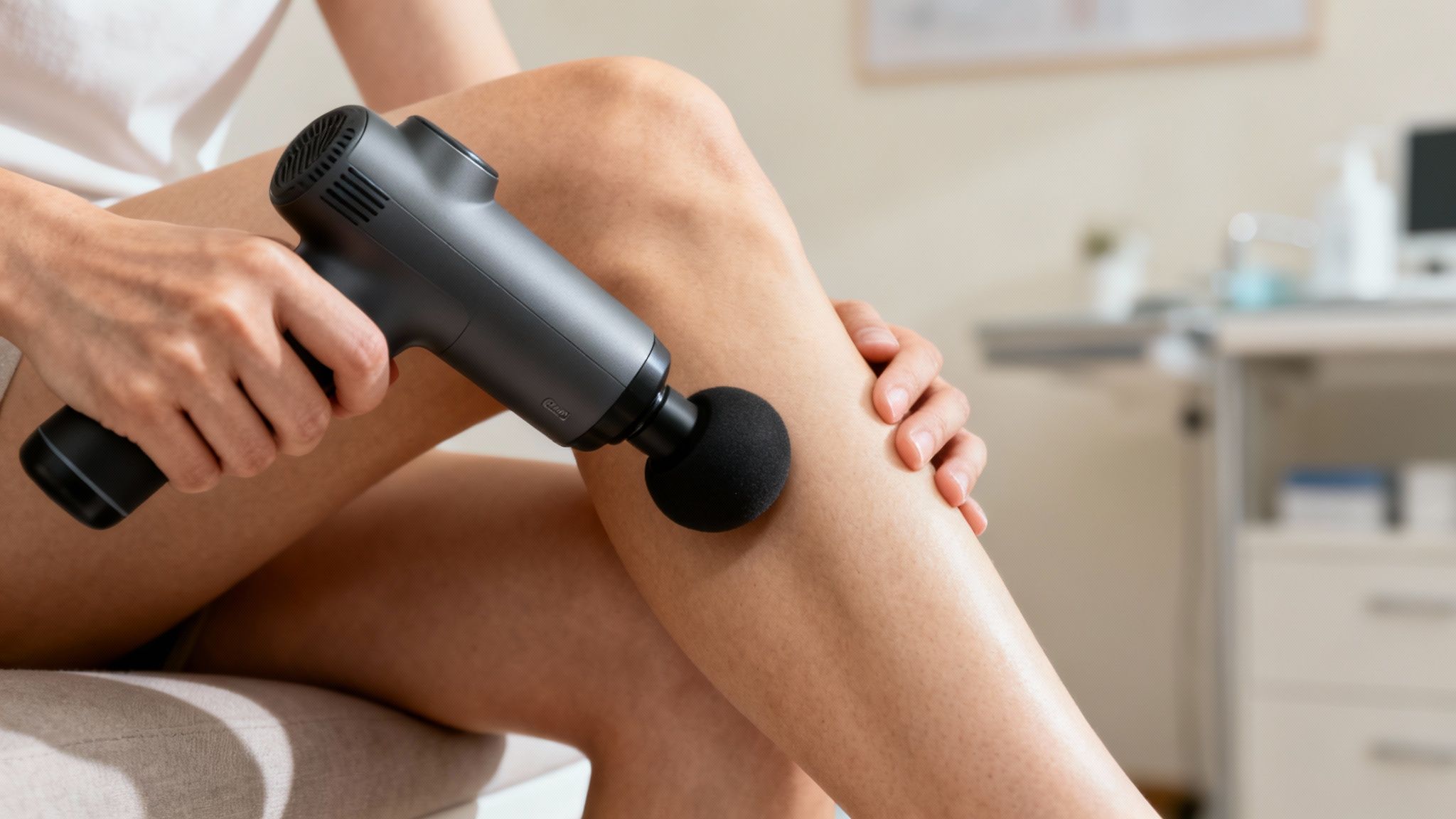
If you've ever dealt with stubborn muscle knots or persistent stiffness, you’ve probably wondered what’s really going on beneath the surface. Myofascial release is a powerful, hands-on therapy designed to target your body’s connective tissue, or fascia. The goal is to apply gentle, sustained pressure to release restrictions, soothe soreness, and restore your natural range of motion.
This guide breaks down exactly what myofascial release therapy is and how you can use it to feel and move better. It’s a favorite technique for everyone from elite athletes to office professionals looking to undo a long day of sitting.
A Simple Guide to Myofascial Release
You know that nagging “knot” in your shoulder that never seems to go away? That tightness often isn’t in the muscle itself but in the fascia surrounding it. Think of fascia as a thin, surprisingly strong web of tissue that wraps around everything inside you—every muscle, bone, and organ.
When you’re healthy, this fascial web is supple and allows your muscles to glide past each other smoothly. But things like poor posture, an old injury, or repetitive movements can cause this web to become tight and restricted. These problem areas are often called trigger points, and they’re notorious for causing discomfort and limiting how well you can move.
How Does It Actually Work?
Myofascial release works by applying slow, deliberate pressure directly onto these tight spots. This isn’t your typical deep-tissue massage. Instead, the aim is to gently stretch and lengthen the fascia, coaxing it to return to its normal, flexible state.
It’s like trying to smooth out a wrinkled t-shirt. You have to gently pull the fabric and hold it until the creases release. That’s exactly what myofascial release does for your body’s internal fabric.
Myofascial Release at a Glance
This table simplifies the key concepts behind the therapy.
| Concept | Simple Explanation |
|---|---|
| Fascia | A web of connective tissue wrapping every muscle and organ. |
| Trigger Points | Tight, restricted “knots” that form in the fascia. |
| The Technique | Applying slow, sustained pressure to stretch and release the fascia. |
| The Goal | Promote flexibility, reduce soreness, and support better movement. |
This gentle but powerful technique can help you:
- Ease muscle soreness and stiffness from a tough workout or a long day at your desk.
- Improve your flexibility and range of motion, making everyday movements feel smoother.
- Support circulation to areas that need it most, promoting your body’s natural recovery process.
"I sit at a desk all day, and my neck and shoulders were always tight. Learning about myofascial release was a game-changer. A few minutes with my Cryotex at the end of the day helps me feel so much looser." - Jessica T., Chicago, IL
You can learn even more about its benefits in our comprehensive guide to muscle recovery.
Understanding Fascia: Your Body’s Hidden Network
Before we dive deeper into myofascial release techniques, you have to get to know fascia. Think of it as a delicate, web-like connective tissue that weaves through your entire body, giving you structure and shape. When your fascia is healthy, it's flexible and lets your muscles glide smoothly.
But things like stress or sitting too long can cause this tissue to tighten up and get stuck. Those restrictions create painful trigger points we call “knots.” A tight spot in your shoulder, for instance, can tug on fascia connected all the way to your neck, leading to stiffness and discomfort. This is why keeping your fascia healthy is a game-changer.
The Role of Fascia in Daily Movement
The idea that fascia is critical to our well-being isn’t new. It has a rich history rooted in osteopathic medicine. Andrew Taylor Still, who founded the practice in the late 1800s, was one of the first to recognize how important this tissue is for the body to function correctly. His work laid the foundation for many manual therapies used today. You can learn more about the history of this practice and how it evolved.
This diagram helps visualize how fascia, trigger points, and release are all connected.

As you can see, the smooth fascia can develop knots (trigger points), which then need targeted pressure to let go. That’s the core principle behind why myofascial release works so well to restore movement and reduce discomfort.
The Real-World Benefits of Releasing Your Fascia
So we've covered the science, but what do the benefits of myofascial release actually feel like? When you start working on those fascial restrictions, you’re giving your body a chance to move freely and recover the way it was designed to. For an office worker, this might mean finally shaking that nagging neck stiffness. For a runner, it could be the difference between tight calves and legs that feel fresh for the next run.
1. Support Recovery and Reduce Soreness
One of the first things people notice is a reduction in muscle soreness. After a tough workout, the fascia around your muscles can clamp down, leading to that familiar delayed onset muscle soreness (DOMS). Myofascial release helps support circulation to those overworked areas, promoting your body's natural healing process.
2. Improve Your Flexibility and Range of Motion
Ever feel stiff, even if you stretch all the time? Your fascia might be the culprit. When it’s tight, it physically restricts how far your muscles can lengthen, limiting your flexibility. Releasing those restrictions is like giving your muscles more room to breathe and move, unlocking a greater range of motion.
3. Find Deep, Lasting Relaxation
Chronic tension often has deeper roots than just "tight muscles." When parts of your fascial network are stuck, they can send stress signals throughout your body. Myofascial release helps calm the nervous system, easing the chronic muscle "guarding" that fuels feelings of tension and stress. This can leave you with a profound sense of well-being.
How to Start Self-Myofascial Release at Home
You don’t need a professional appointment to start feeling the benefits of myofascial release. With a few simple tools, you can build your own self-myofascial release (SMR) practice at home. This approach puts you in control, empowering you to tackle everyday aches on your own schedule.
The idea is to use your body weight and some basic gear to apply focused pressure on fascial restrictions—think tight hips or stubborn shoulders.

Essential Tools for At-Home Release
Getting started is easier than you think. You only need one or two key items.
- Foam Roller: This is the go-to tool for SMR. It’s perfect for large muscle groups like your quads, hamstrings, and upper back.
- Massage Ball: For more detailed work, a lacrosse ball or a dedicated massage ball is your best friend. It lets you zero in on smaller trigger points in places like your glutes or shoulders.
The secret is to move slowly. When you hit a tender spot, pause and hold the pressure for 30–60 seconds. This sustained pressure gives the fascia time to relax and let go.
Both professional therapy and at-home work have their place. Here’s a quick comparison.
Professional Therapy vs At-Home Release
| Feature | Professional MFR | Self-Myofascial Release (SMR) |
|---|---|---|
| Expertise | Performed by a trained therapist | Self-directed |
| Precision | Highly targeted and specific | General, but effective for large areas |
| Cost | Session-based fees | One-time cost for tools |
| Convenience | Requires an appointment | Anytime, anywhere |
| Best For | Chronic discomfort, complex issues | Daily maintenance, post-workout |
The best approach often involves a mix of both. A therapist can help with complex issues, while daily SMR keeps you feeling great.
A Simple Routine to Get Started
Ready to give it a shot? Here’s a simple exercise for the upper back, a classic trouble spot for desk workers.
- Positioning: Lie on your back with a foam roller horizontally under your shoulder blades. Bend your knees with your feet flat on the floor.
- Support: Cross your arms over your chest. This helps expose the muscles underneath. Lift your hips slightly to put your weight onto the roller.
- The Roll: Gently roll up and down, from the middle of your back to the top of your shoulders. Avoid rolling directly on your neck or lower back.
Remember, consistency trumps intensity. Just a few minutes of SMR each day can make a world of difference.
Using Percussive Therapy for Deeper Release
Modern tools have made it easier than ever to get the benefits of myofascial release at home, and percussive therapy is leading the way. A quality massage gun acts as a powerful SMR tool, using rapid pulses to get deeper into muscle and fascial tissues than a foam roller can.
This is where a device like the Cryotex Massage Gun shines. It delivers the focused, consistent pressure needed to address stubborn knots and trigger points. The quick percussions warm up the fascia and drive blood flow to the area, kickstarting your body’s natural recovery process. It’s an efficient way to get the job done without the effort of rolling on the floor.

Getting the Most from Your Massage Gun
To get the most from your SMR session, pick the right attachment. Each head is designed for a specific job.
- Ball Head: This is your all-purpose attachment, perfect for large muscle groups like your glutes, quads, and back.
- Bullet Head: Grab this one for laser-like precision on deep trigger points in your shoulders or the arches of your feet.
- Flat Head: This option is great for muscular areas that can take more intensity, like your pecs or IT bands.
Always start on the lowest speed setting and float the massage gun over the muscle. When you find a sore spot, hold the gun there for about 30 seconds. Let the percussions do the work.
"I use my Cryotex after every long run. The bullet head attachment is a lifesaver for the knots I get in my calves. It helps me feel ready for my next training session." - Mark R., New York, NY
Remember to be smart: avoid using your massage gun directly on bones, joints, or your spine. To learn more, check out our guide on what a massage gun does.
Essential Safety Tips for Myofascial Release
Getting started safely is key to unlocking the benefits of myofascial release. Before you grab a foam roller or your Cryotex massage gun, it’s important to know a few ground rules to ensure your sessions are both effective and safe. The number one rule? Always listen to your body.
You should expect to feel mild discomfort or a "good hurt," but never sharp or intense pain. If you feel anything that makes you wince, that’s your body telling you to ease off.
Key Guidelines for Safe SMR
To keep your practice productive, focus on muscles, not bones.
- Avoid Bones and Joints: Never apply heavy pressure on your spine, kneecaps, or other bony areas. The goal is to release the soft tissue around these structures.
- Stay Away from Sensitive Areas: Be gentle around your neck, abdomen, and groin to avoid irritating nerves.
It's also a smart idea to talk to a healthcare professional before starting if you have any underlying health conditions, such as osteoporosis, deep vein thrombosis (DVT), open wounds, or recent fractures.
Finding Your Rhythm
When it comes to myofascial release, consistency is more important than intensity.
Short, regular sessions are better for your body than one long, aggressive session. Start with just a few minutes a day on one muscle group and see how you feel. For a more detailed look at scheduling, our guide on how often you should use a massage gun is a great resource.
Remember, the goal is to gently coax your fascia into a relaxed state, not force it. By following these simple safety tips, you can confidently make myofascial release a sustainable part of your wellness journey.
Your Myofascial Release Questions, Answered
Let's clear up some common questions people have about myofascial release.
How Often Should I Do Myofascial Release?
For general wellness, aiming for 2-3 sessions per week is a great starting point. If you’re an athlete or dealing with a stubborn knot, you might find that short, daily sessions on those problem areas provide better results. The most important thing is to listen to your body and find a consistent rhythm.
Is Myofascial Release Supposed to Hurt?
You should feel a satisfying pressure or mild discomfort on tight spots—a "good hurt." However, it should never feel sharp, stabbing, or unbearable. If you hit a point of intense pain, that’s your body’s signal to ease up on the pressure immediately.
How Is This Different From a Regular Massage?
While both can help you relax, they work on different things. A traditional massage focuses on easing general tension in the muscles. Myofascial release goes a level deeper to target the fascial system, using slow, sustained pressure to stretch and unstick restrictions in that connective web. This helps restore mobility and address discomfort at its source.
Ready to experience deeper relief at home? BestMassageGun.com makes pro-level recovery simple and accessible.
Shop the Cryotex Holiday Bundle — 4 FREE Turkish Towels